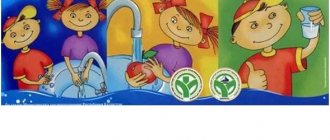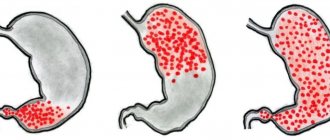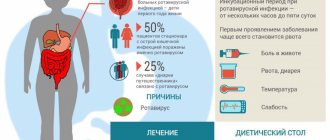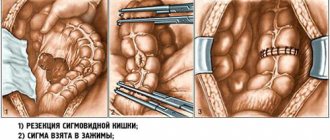Article verified by Euromed Kids doctors
There are many infectious diseases that affect the digestive system. Common symptoms of an intestinal infection:
- intoxication (fever, headache, weakness);
- stomach ache;
- nausea and vomiting;
- diarrhea.
In addition to these symptoms, some intestinal infections also have their own manifestations, for example, blood in the stool or a specific type of pain, which can be important for diagnosis.
Diagnosing intestinal infections is not always easy. We recommend contacting us to conduct a rapid test for intestinal infections to quickly and correctly select the method and place of treatment.
How does an intestinal infection occur?
Viruses, bacteria and protozoa that cause intestinal infections live in the stool, saliva, urine and vomit of patients. Then they can get into water, food, and various objects, and thus infect other people. Therefore, measures to prevent intestinal infections are to wash your hands, as well as fruits, vegetables and berries, maintain hygiene after using the toilet, do not drink from the same bottle with others, use only your own spoon and fork.
Do not consume unboiled milk; thoroughly boil or fry meat. An intestinal infection can be contracted by swimming in dirty water and in many other ways. Some intestinal infections, especially viral ones, are transmitted through household contact.
Clinical picture of OKI
Intestinal infections are common diseases.
The clinic of all acute intestinal diseases is characterized by common manifestations:
- Infectious toxic syndrome. A sharp increase in body temperature to low-grade or high or fever. Manifestations of intoxication of the body are aches, muscle pain, nausea.
- Intestinal syndrome. Abdominal pain, severe diarrhea and vomiting. Depending on the type of pathogen that has entered the body, manifestations of intestinal syndrome differ in the localization of pain, consistency, stool color and frequency, the presence of mucus or blood in the stool, and the nature of vomiting.
- Dehydration of the body. Rapid dehydration and rapid weight loss. Acute lack of moisture in the tissues of the body (dry skin and mucous membranes, severe thirst).
The first symptoms of the disease appear 6-48 hours after infection.
What organs are affected by intestinal infections?
Intestinal infections can be classified according to the organ that has been “attacked” by microbes:
- gastritis - inflammation of the gastric mucosa. It manifests itself as pain in the abdomen above the navel, constant nausea, and repeated vomiting. Diarrhea is not typical, but there may be loose stools 1-4 times. Acute infectious gastritis usually develops when infected with Staphylococcus aureus (food poisoning) or viruses.
- gastroenteritis - inflammation of the mucous membrane of the stomach and small intestine. It manifests itself as pain in the abdomen around the navel, vomiting, frequent stools, first mushy, then watery, with undigested food debris. Usually develops with viral intestinal infections or damage by pathogenic strains of Escherichia coli.
- enteritis - inflammation of the mucous membrane of the small intestine. It manifests itself as frequent watery stools without nausea, vomiting and abdominal pain. Enteritis can develop, for example, with cholera (but also in other cases).
- gastroenterocolitis - inflammation of the mucous membrane of the stomach, large and small intestines. It manifests itself as abdominal pain, pain during bowel movements, frequent loose stools, sometimes with blood and mucus. Characteristic for salmonellosis.
- enterocolitis - inflammation of the intestinal mucosa (small and large). It manifests itself as severe abdominal pain, frequent urge to have bowel movements, loose stools (sometimes in the end only mucus is released). Characteristic of salmonellosis and dysentery.
- colitis - inflammation of the large intestine. It manifests itself as pain in the lower abdomen, diarrhea, sometimes with blood and mucus. Characteristic of dysentery.
Quality treatment
Attapulgite - used in cases of diarrhea.
Treatment of this disease should include many measures. Before removing harmful bacteria, it is necessary to eliminate toxins from the body, and then normalize the water balance in the body.
With the help of vomiting and diarrhea, toxins begin to leave the body, and therefore these symptoms can be called to some extent positive.
To remove intestinal disease, it is necessary to rinse the stomach. This can be done using a regular enema. In addition, the disease can be cured using sorbents that can remove toxins from the body. These include:
- Smecta;
- Polyphepan;
- Attapulgite.
When a patient develops intestinal disease, a fasting diet must be followed. This is necessary because food causes an increase in bacteria. You can eat viscous porridges, such as oatmeal, but without salt. It will calm the intestines. It is possible to cure this disease using a solution of rehydron or behydron.
Viral intestinal infections
Rotavirus infection
Children most often suffer from rotavirus infection. As a rule, adults have developed immunity, because almost everyone suffered from rotavirus in childhood.
Symptoms of rotavirus:
- temperature rise to 38-39;
- cramping abdominal pain;
- weakness, loss of appetite;
- repeated vomiting;
- diarrhea up to 10-15 times a day, stools are liquid, foamy, brown-yellow, after 1-2 days - clayey, yellowish-gray;
- sometimes - sore throat, runny nose, conjunctivitis.
There is a Rotatek vaccine against rotavirus. While it is not included in the Russian calendar, it can be done for a fee. We advise you to vaccinate your child, as rotavirus can be very dangerous for children under two years of age, quickly causing dehydration and causing serious complications.
Adenovirus infection
Adenoviral enteritis is commonly called “intestinal flu.” This virus affects the small intestine, stomach, large intestine - all at once. Children get sick more often, but adults too. In addition to the usual route of transmission of intestinal infections, adenovirus can be contracted through airborne droplets through contact with a patient.
Symptoms of adenoviral enteritis:
- abdominal pain;
- moderate nausea and vomiting;
- loose stools several times a day, often with a greenish tint;
- rumbling in the stomach;
- temperature rise to 38 and above (can persist for 3-5 days);
- pallor, dry tongue.
Adenovirus in young children and the elderly is fraught with complications, especially dehydration.
Enterovirus infection (Coxsackie viruses A and B, ECHO viruses)
Enteroviruses are a common name for more than 100 types of viruses that reproduce in the gastrointestinal tract. Almost all of them are pathogenic and dangerous because they can live outside the body for a long time and are extremely difficult to destroy. Thus, enteroviruses can live in moist soil and enter the body through poorly washed vegetables; even in chlorinated water, enteroviruses remain viable for 3-4 months. It is not surprising that enteroviral intestinal infections are very common. Children endure them more severely than adults.
Most often, enterovirus infections begin acutely, with an increase in temperature, which can then either rise or normalize. Diarrhea, nausea, vomiting, weakness, lack of appetite and headache also occur. At the same time, symptoms characteristic of ARVI may appear - itching and sore throat, runny nose and cough.
Enterovirus infection can cause relapses: symptoms subside and then develop with renewed vigor.
Symptoms in adults?
The first symptoms of infection may not be noticeable.
A stomach infection, the symptoms of which every doctor recognizes, can masquerade as other diseases. Very often, the development of the disease occurs without symptoms, which does not allow it to be detected immediately. The most well-known symptoms of the development of intestinal diseases are:
- Constant aching pain in the abdominal area. It appears due to the presence of bacteria. Usually the pain is not prolonged, but comes in spasms that do not last long (3–4 minutes).
- Diarrhea, as pathogenic microorganisms are present in the body. In such a situation, you should pay attention to the fact that dehydration may occur (this will worsen the situation).
- Reluctance to eat.
- Difficulty with bowel movements.
- Irritable bowel syndrome.
- Insomnia. The question may arise - how is this related to gastrointestinal diseases? In such a situation, the infection causes irritation in the person, which impairs the quality of sleep. During sleep, the body uses the liver to remove toxic substances, but this is not always possible.
- Weak immunity. Bacteria begin to absorb nutrients, weakening the body. This can lead to the development of anemia.
- Grinding of teeth during sleep.
- Depressed state, headaches - this indicates that there is a yeast infection in the body. If you have headaches, you should go to the hospital immediately.
- Rash, itching, and burning.
- Nausea and vomiting. Nausea with varying degrees of intensity.
Bacterial intestinal infections
Botulism
Botulism is a rare but dangerous intestinal infection, as it affects the nervous system, leads to extremely serious consequences and is difficult to diagnose. Botulism can be contracted from eating home-canned food (no outbreaks associated with factory-made canned food have been reported in recent decades), or less commonly through contact with someone who is sick (usually infants).
Botulism begins with short-term nausea and vomiting, then a feeling of fullness in the abdomen occurs - a consequence of paresis (partial paralysis) of the intestines and stomach. Then muscle weakness, dry mouth, and visual disturbances (fog before the eyes) appear. By the end of the first day of illness, respiratory failure may develop. Mortality without treatment is 30-60%. With a timely diagnosis (this can be difficult due to the fact that this infection is rare, and the manifestations are easily confused with many other diseases), the victims are given an toxoid, and, as a rule, a gradual recovery occurs within 2-3 weeks.
Dysentery (shigellosis)
Dysentery is a common disease caused by Shigella bacteria. Amoebic dysentery, caused by protozoa, also occurs. People of all ages are susceptible to dysentery, but 60% of patients are children under 4 years of age.
Dysentery begins acutely with abdominal pain and stool upset (10-20 times a day). By the end of the first day, “spit-shaped stool” consisting of pus, mucus and blood is characteristic. On days 2-3, the manifestations of dysentery are maximum. The temperature can reach 39, and in severe forms, rise even higher. The patient is pale, the tongue is covered with a brown coating. A characteristic sign of dysentery is sharp pain when palpating the left iliac region. With severe dysentery, serious complications can develop, including peritonitis. Dysentery is extremely dangerous for young children and must be treated in a hospital. The temperature in moderate forms of dysentery usually decreases on the 4-5th day of illness, but complete recovery occurs only after 2-3 weeks.
Bacterial intestinal infections also include salmonellosis, staphylococcal food poisoning and cholera. It is extremely important to distinguish dysentery from food poisoning, and if treatment is necessary, to make it easier for the doctor to quickly and correctly choose an antibiotic.
In our clinic you can undergo express diagnostics in just 1 hour to identify 4 viruses that most often cause intestinal infections! Click to find out more.
Criteria for diagnosing diarrhea
- Determining the type of diarrhea can indirectly indicate not only a possible etiological factor, but will also allow a differentiated approach to the construction of therapeutic, pathogenetically based tactics.
- It has been established that the same pathogen of acute intestinal infections can in some cases cause an “invasive” type of diarrhea with the development of an inflammatory process in the intestine, and when infected with strains of the same bacteria capable of producing enterotoxins, it can cause a “secretory” type, and if the ability to invade is preserved, it can cause “secretory” type of diarrhea. “mixed” invasive-secretory.
How can you tell if dehydration is developing?
Intestinal infections lead to the body losing water and salts (sodium, potassium, chlorine, etc.) due to vomiting and diarrhea. Dehydration is one of the main dangers of an intestinal infection, as it can very quickly lead to death, especially in young children. A parent should be wary if he sees the following signs:
- dry mucous membranes of the mouth and tongue;
- grayish skin;
- saliva viscosity increased;
- the child is lethargic, sleepy;
- the baby’s fontanelle on the head sinks, the pulse quickens;
- the baby peed twice or less in 12 hours, the amount of urine is small, it may be dark, with a strong odor;
- intense vomiting, the child cannot be given anything to drink. In this case, you should go to the hospital, where the child will be given a drip and the fluid balance in the body will be restored.
Why does it happen?
Poor nutrition can serve as a breeding ground for infection.
When a weakened body cannot fight against viruses, diseases such as:
- Escherichiosis;
- klebsiellosis;
- dysentery;
- salmonellosis;
- diarrhea;
- staphylococcal infection.
These phenomena are the cause of intestinal infections. The appearance of these diseases is facilitated by a lack of normal nutrition, eating dirty vegetables, and drinking water that contains these bacteria. When they enter the body, they are sent through the stomach to the intestines.
How to feed a child with an intestinal infection?
If you are being treated at home and your child is vomiting and has diarrhea, the most important thing is to give your child the right amount of water. Often, if a sick child drinks several sips at once, this can trigger vomiting and he will lose even more fluid. Therefore , it is recommended to feed the child every 5-10 minutes, giving him 5-15 ml of liquid at a time. You should not give your child only clean water, as this can lead to a salt imbalance.
You can give your child a pharmaceutical rehydrate solution (for example, Regidron) or prepare such a solution yourself. However, if the child does not drink at all, the choice should be made in favor of any liquid that he agrees to swallow.
Sources
- Ploskireva A.A. Acute intestinal infections in pediatric practice. 2016. Nurse.
- Tikunova Nina Viktorovna, Zhirakovskaya Elena Vladimirovna Viruses are causative agents of intestinal infections. 2012. First-hand science;
- Khalyavina A. A., Savinykh M. V. Epidemiology of acute intestinal infections. 2009. Vyatka Medical Bulletin;
- Bondarenko Alla Lvovna, Lyubeznova Olga Nikolaevna, Poponin Mikhail Vasilievich, Glushkova Tatyana Vladimirovna, Yakovleva Irina Aleksandrovna, etc. Differential diagnosis of acute intestinal infections. 2011. Vyatka Medical Bulletin;
- Nikonorova Marina Anatolyevna, Saldan Igor Petrovich, Karbysheva Nina Valentinovna, Pak Sergey Grigorievich, Belaya Olga Fedorovna, etc. Acute intestinal infections in outpatient practice. 2022. Epidemiology and infectious diseases.
- N. E. Filichkina, N. A. Shibeko, I. V. Ryazhechkina, N. V. Khamtsov Epidemiology of acute intestinal infections. 2005. Bulletin of the Smolensk State Medical Academy.
Video from YouTube on the topic of the article:








